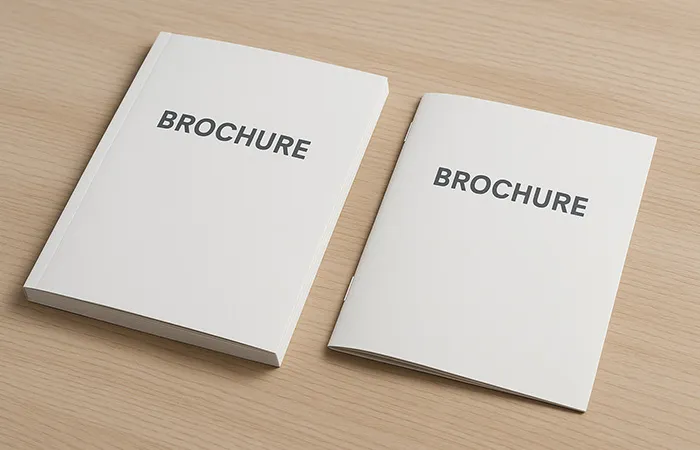
Choosing between perfect bound and saddle-stitched binding isn’t just about style—it impacts your project's cost, durability, usability, and final impression. Whether you're producing a brochure, catalogue, magazine, or paperback book, understanding these two popular binding methods helps you make a smarter decision that aligns with your content, budget, and distribution strategy.
Both saddle-stitching and perfect binding have clear advantages. Saddle-stitching is ideal for simplicity and speed; perfect binding adds polish and longevity. By comparing your project's goals—budget, number of pages, visual expectations, and shelf presence—you can confidently choose the best solution.
Which Binding Is Most Cost-Effective?
Saddle-stitching is your go-to option when budgets are tight or page counts are low. Perfect binding costs more but delivers higher value and impact—especially important when your book is sold or needs shelf appeal. For best results, get a side-by-side quote from your printer to weigh both options fairly.
Technical Details of Saddle-Stitched Binding
Saddle-stitched binding involves folding printed sheets and stapling them through the fold line with metal wire staples. This method is suitable for documents with 8 to 80 pages, depending on paper thickness. It works best with 80–130 gsm inner pages and lightweight covers up to 250 gsm. Saddle-stitching is quick and economical, but has limitations in terms of spine thickness and durability. The finished product lies relatively flat and is ideal for short-term publications like brochures, catalogues, and reports.
Technical Details of Perfect Binding
Perfect binding uses a strong adhesive to glue the trimmed edges of pages into a squared-off spine, then affixes a wraparound cover. Suitable for books from 40 to 300+ pages, it requires precise spine thickness calculation based on the number of pages and paper weight. Inner paper typically ranges from 80 to 170 gsm, with covers from 250 to 350 gsm. Lamination is often added for strength and finish. Perfect binding offers a professional look and is commonly used for magazines, manuals, novels, and corporate documents.
Minimum and Maximum Page Limits by Binding Type
Each binding method has page count thresholds. Saddle-stitched books generally require a minimum of 8 pages and a maximum of 64–80 pages, depending on paper weight. Exceeding this may cause bulging or poor alignment. Perfect binding becomes viable from 40 pages onwards and can handle up to 300–400 pages comfortably, provided spine thickness and glue type are suitable. For projects exceeding this range, options like PUR binding or sewn hardcover may be necessary. Matching page count to binding is essential for proper durability and appearance.
Visual Impact: How Binding Affects Perception
Binding plays a significant role in the perceived value of a publication. Saddle-stitched books appear simple and functional, making them suitable for short-term or informational use. In contrast, perfect-bound books offer a sleeker finish and a printable spine, enhancing shelf presence and branding. For creative or high-end projects, the binding choice can reinforce the message—hardcover adds prestige, while spiral suggests practicality. A well-chosen binding elevates the reader’s impression before even opening the cover.
Reader Experience: Flat Lay vs. Flexibility
User comfort is influenced by how a book opens and lies flat. Saddle-stitched books open easily and stay flat, making them ideal for reading, browsing, or note-taking. Perfect-bound books may resist lying flat, particularly in lower page counts or with stiff paper, which can make reading near the spine challenging. For workbooks or manuals, spiral or wire-o binding allows full 360° page turns and true flat lay. When planning your publication, consider how your readers will interact with the content—not just how it looks.
How Binding Affects Shipping Costs
Saddle-stitched documents are lighter and thinner, making them easier and cheaper to ship. Perfect-bound books are bulkier and add weight, especially in high quantities. That said, they also travel better and look more professional on arrival. Consider where and how your books will be distributed to optimise logistics.
Smart Design to Match Your Binding
Adapting your file to the binding method is key to avoiding layout problems. For saddle-stitched books, align your content to prevent misfolding. For perfect-bound books, avoid putting important elements near the spine, and ensure you calculate spine width precisely. We can help you prepare files correctly for each type.
Need Help Deciding?
Our team can walk you through the pros and cons of saddle-stitching vs perfect binding for your exact needs. From helping you estimate costs to providing file templates and paper suggestions, we’re here to make sure your final product looks great and fits your budget. Request a quote or send us your project specs to get expert advice.